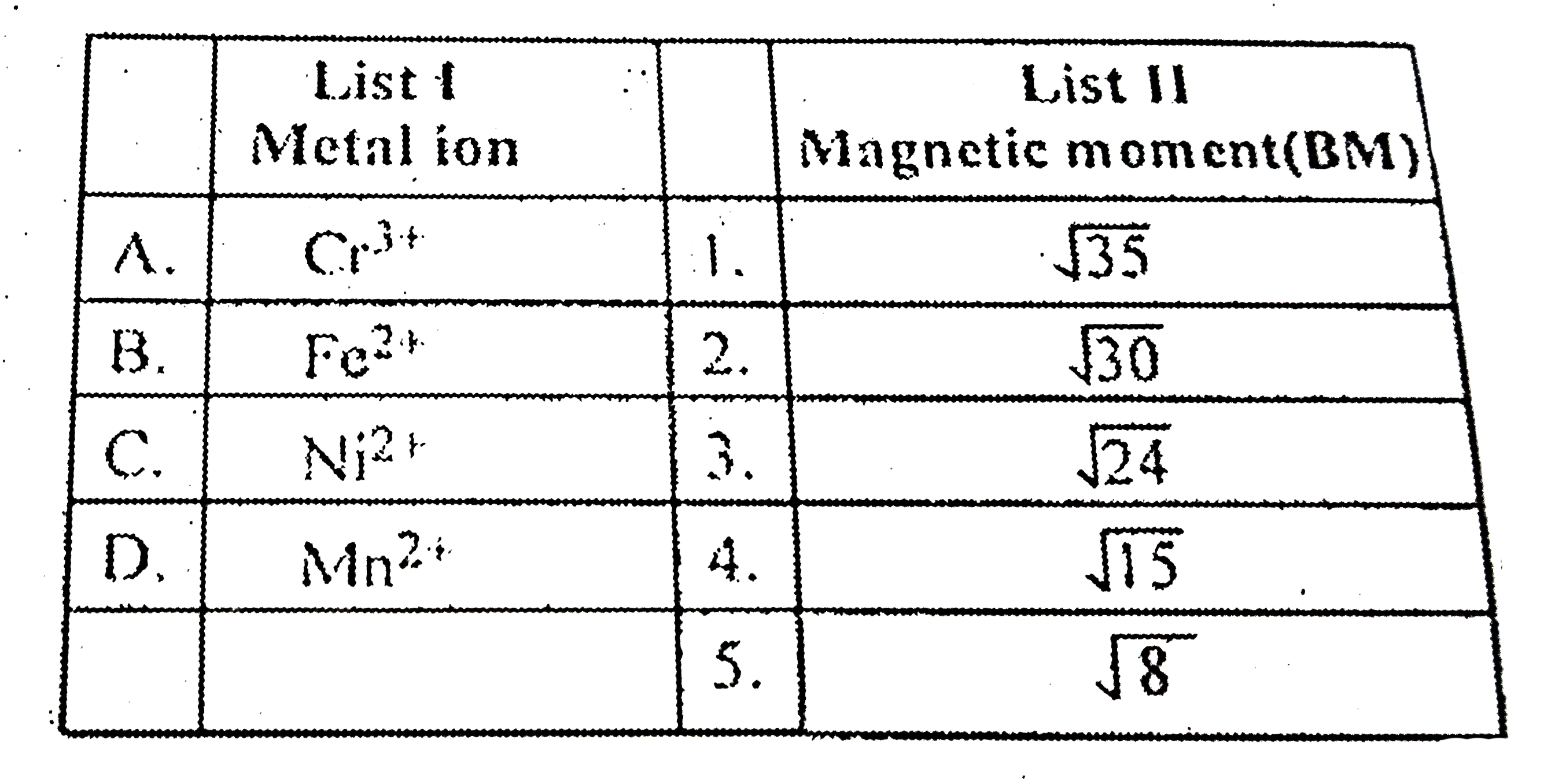Match list-I with list-II and select the correct answer using the codes given below
List- I List - II Ion Radius (in pm) (I)Li+(a)216(II)Na+(b)195(III)Br−(c)60(IV)I−(d)95
Codes :
IIIIIIIVabdc
IIIIIIIVbcad
IIIIIIIVcdba
IIIIIIIVdcba
The correct Answer is:C
To solve the problem of matching the ions with their respective ionic radii, we will follow these steps:
Step 1: Identify the Ions and Their Groups
We have the following ions:
1. Li^+
2. Na^+
3. Br^(-)
4. I^(-)
- Li and Na are Group 1 elements (alkali metals).
- Br and I are Group 17 elements (halogens).
Step 2: Understand Ionic Radius Trends
- Ionic radius increases down a group: This means that as we move from Li to Na (both in Group 1), the ionic radius of Na^+ will be larger than that of Li^+.
- Ionic radius decreases across a period: As we move from left to right in a period, the ionic radius decreases due to increased nuclear charge.
Step 3: Compare the Ionic Radii
1. Li^+ vs Na^+:
- Li^+ has a smaller ionic radius than Na^+.
- Therefore, we expect Li^+ to have a smaller radius than Na^+.
2. Br^(-) vs I^(-):
- I^(-) will have a larger ionic radius than Br^(-) since I is below Br in Group 17.
- Therefore, I^(-) will have a larger radius than Br^(-).
Step 4: Assign the Ionic Radii from List II
Now we will match the ions with their respective ionic radii based on the trends we discussed:
- Li^+: Smallest ionic radius among the given ions. It matches with (c) 60 pm.
- Na^+: Larger than Li^+, matches with (d) 95 pm.
- Br^(-): Larger than Na^+, but smaller than I^(-). It matches with (b) 195 pm.
- I^(-): Largest ionic radius, matches with (a) 216 pm.
Step 5: Final Matching
Now we can summarize the matches:
- (I) Li^+ → (c) 60 pm
- (II) Na^+ → (d) 95 pm
- (III) Br^(-) → (b) 195 pm
- (IV) I^(-) → (a) 216 pm
Step 6: Write the Final Answer
The correct matches are:
- I → c
- II → d
- III → b
- IV → a
Codes:
Thus, the correct answer using the codes is:
C: (I) → (c), (II) → (d), (III) → (b), (IV) → (a).
---
We have the following ions:
1. Li^+
2. Na^+
3. Br^(-)
4. I^(-)
- Br and I are Group 17 elements (halogens).
- Ionic radius increases down a group: This means that as we move from Li to Na (both in Group 1), the ionic radius of Na^+ will be larger than that of Li^+.
- Ionic radius decreases across a period: As we move from left to right in a period, the ionic radius decreases due to increased nuclear charge.
1. Li^+ vs Na^+:
- Li^+ has a smaller ionic radius than Na^+.
- Therefore, we expect Li^+ to have a smaller radius than Na^+.
- I^(-) will have a larger ionic radius than Br^(-) since I is below Br in Group 17.
- Therefore, I^(-) will have a larger radius than Br^(-).
Now we will match the ions with their respective ionic radii based on the trends we discussed:
- Li^+: Smallest ionic radius among the given ions. It matches with (c) 60 pm.
- Na^+: Larger than Li^+, matches with (d) 95 pm.
- Br^(-): Larger than Na^+, but smaller than I^(-). It matches with (b) 195 pm.
- I^(-): Largest ionic radius, matches with (a) 216 pm.
Now we can summarize the matches:
- (I) Li^+ → (c) 60 pm
- (II) Na^+ → (d) 95 pm
- (III) Br^(-) → (b) 195 pm
- (IV) I^(-) → (a) 216 pm
The correct matches are:
- I → c
- II → d
- III → b
- IV → a
Thus, the correct answer using the codes is:
C: (I) → (c), (II) → (d), (III) → (b), (IV) → (a).
Topper's Solved these Questions
- PERIODIC TABLE BOOK - MOTIONCHAPTER - PERIODIC TABLE EXERCISE - Exercise - 2 (Level-I)
20 Videos
- PERIODIC TABLE BOOK - MOTIONCHAPTER - PERIODIC TABLE EXERCISE - Exercise - 3 | Level-I
43 Videos
- PERIODIC TABLE BOOK - MOTIONCHAPTER - PERIODIC TABLE EXERCISE - Unsolved Example
1 Video
- P-BLOCK ELEMENTSBOOK - MOTIONCHAPTER - P-BLOCK ELEMENTSEXERCISE - Exercise - 4 | Level-I Previous Year | JEE Main
37 Videos
- RADIOACTIVITY BOOK - MOTIONCHAPTER - RADIOACTIVITY EXERCISE - EXERCISE - 4 LEVEL - II
20 Videos
Similar Questions
Knowledge Check
Match List-I with List-II and select the correct answer using the codes given below the list:
 AA-2,B-3,C-5,D-1BA-3,B-5,C-1,D-2CA-4,B-1,C-2,D-3DA-4,B-3,C-2,D-1
AA-2,B-3,C-5,D-1BA-3,B-5,C-1,D-2CA-4,B-1,C-2,D-3DA-4,B-3,C-2,D-1Match List -I with List -II and select the correct answer using the codes given below the lists:
 AA B C D4 1 2 3BA B C D1 3 2 4CA B C D2 2 3 1DA B C D2 1 4 3
AA B C D4 1 2 3BA B C D1 3 2 4CA B C D2 2 3 1DA B C D2 1 4 3Match List-I with List-II and select the correct answer using the codes given below the list:
 AA-2,B-1,C-4,D-3BA-1,B-2,C-3,D-4CA-4,B-3,C-1,D-2DA-2,B-1,C-3,D-4
AA-2,B-1,C-4,D-3BA-1,B-2,C-3,D-4CA-4,B-3,C-1,D-2DA-2,B-1,C-3,D-4
Match List-I with List-II and select the correct answer using the codes given below the lists :

View SolutionMatch List-I with List -II and select the correct answer using the code given below the Lists.

View SolutionMatch list I with list II and select the correct answer using the codes given below the lists.

View SolutionMatch List-I with List-II and select the correct answer using the code given below the Lists
View SolutionMatch List-I with List-II and select the correct answer using the codes given below the lists:


View Solution


